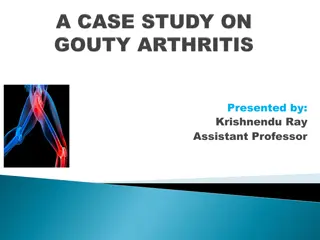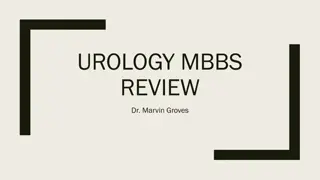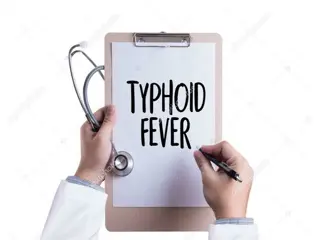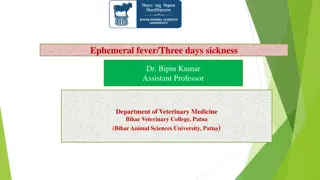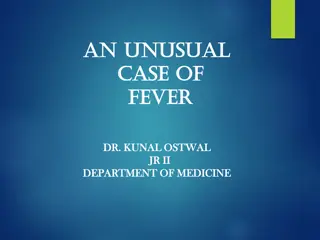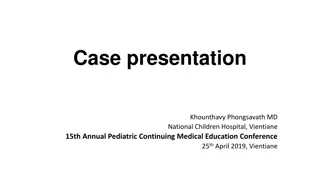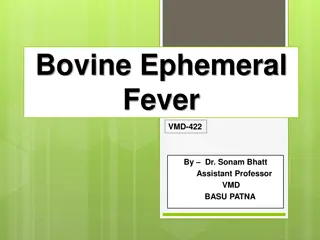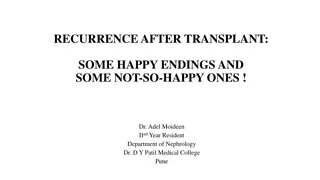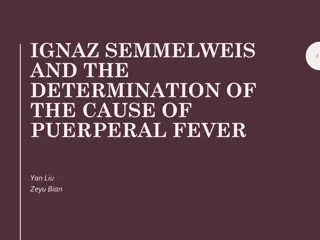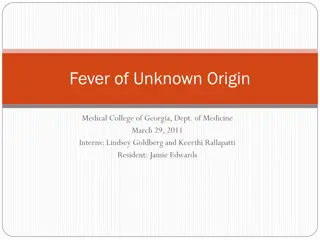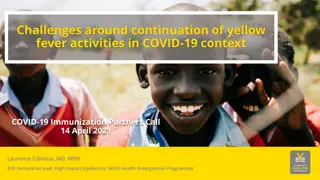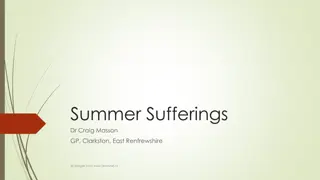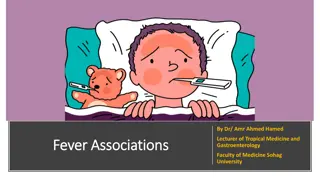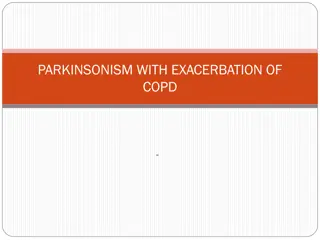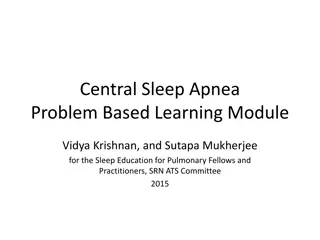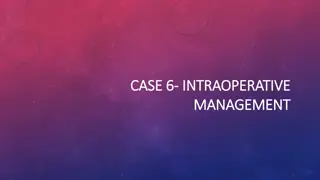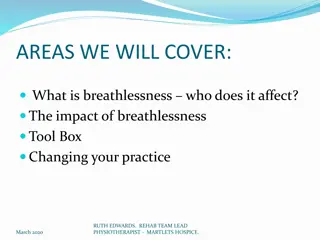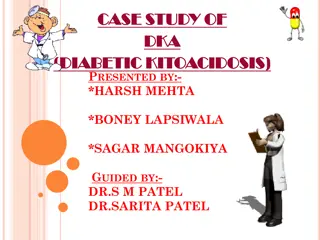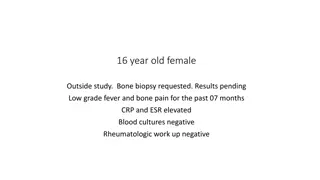Case Study: 55-Year-Old Male Patient with Fever, Breathlessness, and LRTI
A 55-year-old male presented with fever, breathlessness, and a history of Dengue fever. Further investigations revealed Diabetes Mellitus and LRTI with AKI. Treatment included antibiotics and supportive care.
Download Presentation

Please find below an Image/Link to download the presentation.
The content on the website is provided AS IS for your information and personal use only. It may not be sold, licensed, or shared on other websites without obtaining consent from the author. Download presentation by click this link. If you encounter any issues during the download, it is possible that the publisher has removed the file from their server.
E N D
Presentation Transcript
Department of Microbiology Dr. Prachi C. Bhide
Case A 55 year old male patient came to Medicine OPD with complaints of Fever since 8 days. (k/c/o Dengue fever; Dengue IgM antibody: positive- diagnosed at outside laboratory), Platelet count: 1.5lakh/cumm Breathlessness since 3 days Increase in fever spikes since 1 day k/c/o Hypertension No h/o chest pain, vomiting, diarrhea
On examination: o Conscious, oriented o Temp- 1020F o Pulse: 96/min o BP: 130/80 mm Hg
On further investigations; o Patient was diagnosed to have Diabetes Mellitus(DM) o His HRCT revealed bilateral lower zone consolidation o There were 2-3 spikes of fever everyday Hence patient was admitted to MICU with diagnosis of LRTI because of ? Bacterial pneumonia with Acute kidney injury(AKI).
Investigations Complete blood count: Platelet count- 98,000/cu.mm. Rapid malaria test: Negative SGPT: 140 IU/L SGOT: 101 IU/L ALP: 114 IU/L Urine sugar: 2+ HbA1C: 7% Procalcitonin level: Positive(6.7) (Reference range- <0.3ng/ml) SPO2: 93%
Quantitative CRP: 67.8mg/L (Reference range- 0-6 mg/L) To rule out H1N1 flu: Throat swab was sent to National Institute of Virology(NIV): Report was negative for Influenza A(H1N1) & other seasonal Influenza report Dengue IgM by ELISA: Positive Leptospira: Negative Weil-Felix test: Positive Titre: OX 2- 1: 640 OX K- Negative OX 19- 1:1280
Infection Vector Agglutination pattern OX 19 OX2 OXK Epidemic typhus Louse +++ + - Murine typhus Flies +++ + - Endemic typhus Flies +++ + - Rocky Mountain Spotted Fever Tick +++ + - Tsutsugamushi fever Mite - - +++ Scrub typhus Mite Mite - - +++ South African tick born fever Tick + + + Trench fever Louse Louse - - - Q fever Tick - - -
Treatment given: Tab. PCT 500 mg- sos Inj. Fibrinil- 1 ampoule sos Inj. Pan- 40mg 1 OD Tab. Telma AM- 1 OD Non-invasive ventilation Inj. Meropenem 1 g TDS for 3 days Tab. Azee 500mg 1 BD for 3 days. Tab. Doxy 100mg 1 BD for 6 days As Weil Felix test was positive, Tab. Doxycyclinewas continued for 6 weeks further and patient responded well to treatment
Patient got discharged on request after 3 days of admission. He got admitted to another tertiary care hospital for further management. After further follow up with patient by telephonic conversation; it was confirmed that patient responded well to o 6 weeks Tab Doxycycline treatment(100 mg BD) o Symtomatictreatment for Dengue fever
Dengue & co-infection in tropics Acute febrile illness is a common clinical syndrome among patients seeking hospital care in India. Concurrent infection with two agents can result in an illness having overlapping symptoms creating a diagnostic dilemma for the treating physician. Common co-infection with Dengue virus in India o Salmonella Typhi o Chikungunya virus o Plasmodium spp. o Leptospira o Influenza A virus o Ricketssia o JE virus
Discussion: Dengue- a mosquito-borne viral infection Ricketssial infections- caused by Ricketssiaewhich are diverse group of organisms transmitted by arthropod vectors(lice, fleas, ticks, mites) In India, Ricketssial infections are reported from Maharashtra, Tamil nadu, Karnataka, Kerala, Jammu and Kashmir, Uttaranchal, Himachal Pradesh, Rajasthan, Assam and West Bengal. Both diseases have several clinical and laboratory features in common, including rash, thrombocytopenia, and hepatic dysfunction. However, concurrent infection with both pathogens is exceedingly rare, primarily due to the different vectors involved. Concurrent infection with multiple pathogens is common in tropics, posing diagnostic and treatment challenges.
Data on dengue and ricketssial fever co-infection is distinctly limited. Dengue-ricketssial fever co-infection may remain under- diagnosed in tropics, particularly confounded during dengue epidemics. Normal leukocyte counts, early drop in platelets and hypoalbuminemia in dengue patients could be clues to concurrent ricketssial fever infection. Prompt recognition and treatment of ricketssial infection in such cases may reduce unnecessary hospital stay and cost.
Similar case reports from India Pondicherry Institute of Medical Sciences, Puducherry- 2010-2014- 6 cases of Dengue fever- Scrub typhus co-infection I.G. Medical College, Shimla- 2015- 1 case of Dengue fever- Scrub typhus co-infection Himalayan Institute of Medical Sciences, Dehradun- 2015- Rare Co-infection of Malaria, Scrub Typhus and Dengue virus in an Immunocompetent Patient
Take Home Message Very limited data on dengue and ricketssial fever co- infection High index of suspicion about ricketssial fever Additional tests should be done for accurate diagnosis in a case of un-resolving fever in endemic regions to reduce morbidity & mortality
References Mediterr J Hematol Infect Dis. 2016; 8(1): e2016028 The Indian Practitioner. Volume 68, Issue 9, September 2015 Int.J.Curr.Microbiol.App.Sci (2015) 4(5): 295-297 Indian peadeatr. 2010 Feb;47(2):157-64.



